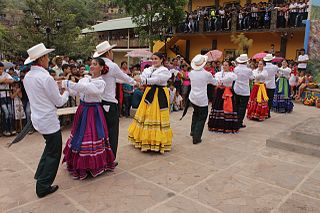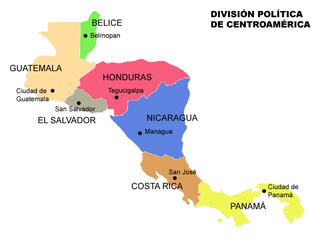
This article is about the ethnic groups and population of Honduras.
The Garifuna people are a people of mixed free African and Amerindian ancestry that originated in the Caribbean island of Saint Vincent and speak Garifuna, an Arawakan language, and Vincentian Creole.

Zambo or Sambu is a racial term historically used in the Spanish Empire to refer to people of mixed Amerindian and African ancestry. Occasionally in the 21st century, the term is used in the Americas to refer to persons who are of mixed African and Native American ancestry.
Afro–Latin Americans or Black Latin Americans are Latin Americans of sub-Saharan African heritage. African heritage is common throughout Latin America.

The wealth of cultural expression in Honduras owes its origins primarily to being a part of Latin America but also to the multi-ethnic nature of the country. The population comprises 80% Mestizo, 8% Amerindian, 2,9% Black, and 3% Caucasian. This influences all facets of the culture: customs, practices, ways of dressing, religion, rituals, codes of behavior and belief systems.

Punta is an Afro-indigenous dance and cultural music of the Belizean & Honduran Garifuna people originating prior to their exile to Honduras from the Caribbean island of Saint Vincent And The Grenadines. Which is also known as Yurumei. It has African and Arawak elements which are also the characteristics of the Garifuna language. Punta is the best-known traditional dance belonging to the Honduran community. It is also known as banguity or bunda.

The Río Plátano Biosphere Reserve is a protected area in the La Mosquitia region on the Caribbean coast of Honduras. With a total area of 5,250 square kilometers (2,030 sq mi), most of the reserve runs along the Río Plátano. The reserve has a number of endangered species and some of the largest remnants of tropical forest in Central America. It has been a World Heritage Site and biosphere reserve since 1982. In 2011, UNESCO placed the reserve on the List of World Heritage in Danger.
The Pech people, previously known as the Paya, are an indigenous ethnic group in north-eastern Honduras. According to a 2007 census conducted by indigenous organisations, 6,024 people self-identified as being of Pech descent. This indigenous group primarily speak in their native tongue, the Pech language, which is a member of the Macro-Chibchan languages. Although, in recent developments, the language is mainly spoken by older generations and is in danger of being extinct in the relative near future.

Utila is the smallest of Honduras' major Bay Islands, after Roatán and Guanaja, in a region that marks the south end of the Mesoamerican Barrier Reef System, the second-largest in the world. It has been documented in history since Columbus' fourth voyage.

The Lenca, also known as Lepa Wiran, meaning “Jaguar People” or “People of The Jaguar” are an Indigenous people from present day southwest Honduras and eastern El Salvador in Central America. They historically spoke various dialects of the Lencan languages such as Chilanga, Putun (Potón), and Kotik, but today are native speakers of Spanish. In Honduras, the Lenca are the largest tribal group, with an estimated population of more than 450,000.

Central America is a subregion of the Americas formed by six Latin American countries and one (officially) Anglo-American country, Belize. As an isthmus it connects South America with the remainder of mainland North America, and comprises the following countries : Belize, Guatemala, Honduras, El Salvador, Nicaragua, Costa Rica, and Panama.

Hondurans are the citizens of Honduras. Most Hondurans live in Honduras, although there is also a significant Honduran diaspora, particularly in the United States, Spain, and many smaller communities in other countries around the world.

An Afro-Guatemalan person is a person who lives in Guatemala, but has African ancestry in their historical and cultural roots. This term intertwines the conquest of America by the Spanish. The Afro-Guatemalan population is not numerous today. Although it is difficult to determine specific figures, it is reported that Afro-Guatemalans represent only between 1% and 2% of the country's population. According to the Council on Hemispheric Affairs. They are of mainly English-speaking West Indian (Antillean) and Garifuna origin. They are found in the Caribbean coast, in Livingston, Puerto Barrios and Santo Tomas. In the 17th century, many enslaved blacks were able to secure for themselves or at least their future children through marriage to free people. Many of these marriages were with Mayans or Europeans, which created a mix between blacks, Mayans and Europeans. This resulted in a significant mestizo population that, over the years, has continued to dilute traces of African ancestry in many cases. Today this can be referred to as Afro-mestizos due to miscegenation.

Afro-Nicaraguans are Nicaraguans of Sub-Saharan African descent. Five main distinct ethnic groups exist: The Creoles who descend from Anglo-Caribbean countries and many of whom still speak Nicaragua English Creole, the Miskito Sambus descendants of Spanish slaves and indigenous Central Americans who still speak Miskito and/or Miskito Coast Creole, the Garifunas descendants of Zambos expelled from St. Vincent who speak Garifuna, the Rama Cay zambos a subset of the Miskito who speak Rama Cay Creole, and the descendants of those enslaved by the Spanish.

Afro-Hondurans or Black Hondurans are Hondurans of Sub-Saharan African descent. Research by Henry Louis Gates and other sources regards their population to be around 1-2%. They descended from: enslaved Africans by the Spanish, as well as those who were enslaved from the West Indies and identify as Creole peoples, and the Garifuna who descend from exiled zambo Maroons from Saint Vincent. The Creole people were originally from Jamaica and other Caribbean islands, while the Garifuna people were originally from Saint Vincent and the Grenadines. Garifunas arrived in the late seventeen hundreds and the Creole peoples arrived during the eighteen hundreds. About 600,000 Hondurans are of Garífuna descent that are a mix of African and indigenous as of Afro Latin Americans. Honduras has one of the largest African community in Latin America.
La Ciudad Blanca is a legendary settlement said to be located in the Mosquitia region of the Gracias a Dios Department in eastern Honduras. It is also known by the Pech name Kahã Kamasa. This extensive area of rainforest, which includes the Río Plátano Biosphere Reserve, has long been the subject of multidisciplinary research. Archaeologists refer to it as being a part of the Isthmo-Colombian Area of the Americas, one in which the predominant indigenous languages have included those in the Chibchan and Misumalpan families. Due to the many variants of the story in the region, most professional archaeologists doubt that it refers to any one actual settlement, much less one representing a city of the Pre-Columbian era. They point out that there are multiple large archaeological sites in the region and that references to the legendary White City cannot be proven to refer to any single place.

The Secretary of State for Culture, Arts and Sports is a Honduras secretary of State responsible for the formulation, coordination, implementation and evaluation of policies relating to research, rescue and dissemination of the cultural heritage, arts education and the identification, preservation and protection of historical and cultural heritage of the nation and all matters relating to the organization, promotion and development of sports.

Garifuna in Peril is a low-budget independent fiction docufiction feature film directed, written, and produced by Alí Allié and Rubén Reyes. The film depicts historical and contemporary issues within the Garinagu Afro-Honduran indigenous community and features a cast of actors from Honduras and Belize.

Honduras has rich folk traditions that derive from the fusion of four different cultural groups: indigenous, European, African and Creole. Each department or region, municipality, village and even hamlet contributes its own traditions including costumes, music, beliefs, stories, and all the elements that derive from and are transformed by peoples in a population. In sum, these define Honduran Folklore as expressed by crafts, tales, legends, music and dances.
Honduras This Week (HTW) was a weekly newspaper published from Tegucigalpa, Honduras. It was edited by Mario Gutierrez Minera. The publisher was Stan Marrder. It operated as Tegucigalpa This Week in 1988-1989 and had an online version, Honduras This Week Online, from 1995 to 2013. Journalists who wrote for the paper include W. E. Gutman, Lynn Chotowetz, Melanie Wetzel and Blanca Moreno.















